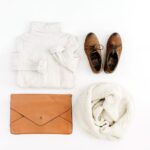You will need a few other tools to sew buttonholes.
- Automatic buttonhole feet: This foot clips to your sewing machine and allows for consistent, perfect buttonholes every time.
- Thread: You can choose from a variety of colors, widths and weights for your sewing machine or hand-sewn projects. Corespun thread is great for buttonholes. Use a cotton thread, or embroidery floss, if you have a thicker material, such as wool. You have the option of matching your button thread with the fabric or using a contrasting color.
- Buttonhole cutter: These are small chisels which cut clear, sharp openings for buttons. Buttonhole cutters work more efficiently than seam rippers.
- Fray stop: Also known as fray check or fray stop, a fray stop is a liquid that prevents your threads fraying when you insert new buttons. To secure the ends of your stitching, use a few drops of this machine-washable liquid.
How to Make Buttonholes in 9 Easy Steps
Before you start learning how to sew buttons, practice on a scrap of fabric. This step-by-step tutorial will show you how to perfect your buttonhole stitch.
- Your fabric should be set up. Before you start sewing, press some lightweight interfacing on the wrong side. This fabric stabilizer or backing will be used as reinforcement underneath the buttonholes.
- Mark the buttonhole positions. Your buttonholes should be spaced evenly. Measure carefully and mark your sewing locations in tailors chalk. The buttonhole markings should look like a T, with lines for the width and height. The best way to measure the distance between buttons is to add the diameter and height of each button together. This will give you the distance between the buttonholes.
- Get your thread ready. Make sure you have enough thread in your bobbin. Attach the buttonhole foot onto your sewing machine.
- Make adjustments to your settings. This sewing activity can be done with a simple zigzag stitch setting. Your machine should have a stitch width of 2.0 and a length of 0.5.
- Place your needle. Line up your needle.
- At the end of your first row, slow down. Once you have reached the bottom of your buttonhole, lift the needle and adjust it to a width 5.0 and a length 0.0. To secure the bar tack, create straight stitches along the bottom of the buttonhole.
- Return to the original setting. Set your initial stitch width and length, and ensure your needle is facing the button line. You can travel backwards. Move the machine towards the opposite end of the tackbar from where you started. When the job is complete, lift the needle.
- Cover the buttonhole gap. To create a top-tack bar, adjust your buttonhole setting (5.0 width, 0. length). This will close the gap between your sew lines.
- The buttonhole should be cut. Two pins should be placed through the fabric at both ends of the buttonhole. To keep the fabric taut, place two pins through your fabric parallel to one another. To create a hole for your button, use a buttonhole cutter.
You may have specific settings that are required to sew buttonholes. To attach the buttonhole foot correctly and to set up your machine for buttonhole sewing projects, make sure you thoroughly read the manual.






